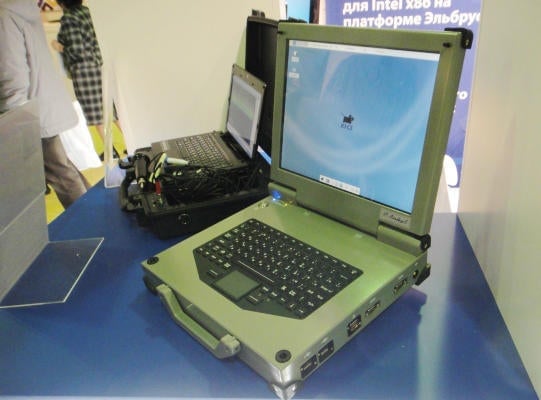This 22-pound “Made in Russia” laptop is actually pretty useful
Last week, on May 25, the Russian and Ukrainian media leapt at the news that “the first Russian laptop” had finally arrived on the market.


Last week, on May 25, the Russian and Ukrainian media leapt at the news that “the first Russian laptop” had finally arrived on the market.
Priced at 150,000 rubles (almost $3,000) and looking more like a coffin than a modern laptop, readers in both countries had a big laugh, until learning later that the story was a fake. The world’s “first Russian laptop” has existed for some time already; it’s not an ordinary consumer product, and you can’t buy it in stores. Meduza’s Sultan Suleimanov takes a closer look at the Russian-made hi-tech devices that lately have been getting a bum rap on the Internet.
The myth of the 22-pound laptop
Last month, a blogger named Vladimir Efimov wrote on Facebook that the “first Russian laptop” had hit the market. It allegedly sported a 1024×768 resolution, a one-hour battery, weighed 22 pounds (about 10 kilos), and cost a whopping 150,000 rubles (almost $3,000). Efimov also attached a photo of a computer that looked like something from the 1980s.
The next thing you know, a story based on Efimov’s blog post appeared on the website 3DNews, and soon the Russian and Ukrainian media were racing each other to report on the subject.

And yet it wasn’t hard to debunk Efimov’s photograph, which had no attribution and originally appeared on the Web more than a year ago. Eventually, Hi-Tech Mail.Ru published a formal denial from the laptop’s alleged manufacturer, the Moscow Center of SPARC Technologies (MCST).
It turns out that the machine is actually a “portable terminal” released in 2012, built to withstand extraordinary environmental conditions. The laptop, which MCST promises will last at least 12 years, can survive being dropped, drowned, and frozen. “It will keep working even if you swim underwater at 50 degrees [122 degrees Fahrenheit] and then use it to smack your enemy over the head,” an employee at MCST joked on his blog in 2014.
And describing this device as a weapon isn’t far off the mark. The laptop was built for field operations—if not military then something close to it. It was not designed for the general public, and so its rugged appearance should come as no surprise.
The $7,500 personal computer
A couple of weeks before reports about Russia’s “22-pound laptop,” several news outlets (admittedly, including this one) published stories about “the first-ever personal computer built with a Russian processor.” This claim turns out to be not entirely accurate.
The machine, named the ARM Elbrus-401, is only available for corporate purchase. Expected buyers are organizations with extraordinarily high security needs, such as the military and other state agencies. Although indeed priced as 400,000 rubles ($7,500), the computer’s manufacturer has no intention of selling the ARM Elbrus-401 to ordinary consumers.
Imported computer processors vs. Russian-built processors
One of the main stories in this new “import-substitution” trend has been the Elbrus processor, also manufactured by MCST since the 1990s, when it was still being developed as part of Soviet supercomputers. The first modern version of this processor passed state testing in 2007. After this, while simultaneously developing another line of processors, MCST continued to release new versions of Elbrus, making each iteration more powerful and modern.
Tests for the Elbrus-4C, MCST’s most advanced processor available today, wrapped up in April 2014, and production began last autumn. The Elbrus-4C is only a quad-core processor, but MCST is already working on the next model: an eight-core chip, the Elbrus-8C, which the company hopes to finish later this year. Until its next-generation processor is ready, MCST says the Elbrus-4C is suitable for servers and desktop computers—and this is where the company seems to be vulnerable to mockery.
Yes, the Elbrus-4C can operate in a simple desktop computer. The processor has specifications that resemble many foreign imports: a quad-core clock speed of 800 MHz, support for three channels of DDR3 RAM, 65-nanometer technology, and a peak performance 50 Gflops, with support for both Windows and Linux.
For comparison, a quad-core Intel Core i7-975 Extreme Edition, released in 2009, is clocked at 3.33 GHz and has a capacity of 53.3 Gflops. Admittedly, it is built on 45-nanometer processor technology, whereas the Elbrus-4C’s 65-nanometer tech dates back to 2006. (The fewer the nanometers, the more efficient the technology is.) Newer processors have reached the level of 22 nanometers.)
Looking at the Elbrus-4C this way, you might be inclined to laugh about the backwardness of Russian computer technology and never look back. It’s not until you consider the processor as a dedicated device specialized for certain tasks that it’s possible to understand its power.
A year ago, the technology website CNews compared computers running the Elbrus-4C and the older Elbrus-2C to a machine using the quad-core Intel Core i7-2600. It tested the different processors’ ability to compress and decompress data, and the Elbrus-powered computers failed to compete, as expected, performing 5-6 times more slowly.
In other tests, however, Elbrus technology did better, performing digital signal processing only 2-2.5 times more slowly than the Intel-powered computer, and it actually outperformed the Intel processor in a data-encryption test (completing the task almost twice as fast!). If you “equalize” the CPU power of these two processors, the Russian architecture for such tasks turns out to be nine times more efficient than the stuff Silicon Valley churns out.
And though they’re hardly designed for personal computers, MCST challenged its Elbrus processors in 2014 to run the popular first-person shooter Doom 3 on Linux, achieving 20 frames per second at a 1920×1080 resolution. The results were impressive.
Russian flash drives
In late May 2015, the Russian media reported that the country’s latest import-substitution effort will be a 512-kilobyte data storage device and a 128-megabyte flash drive.
These products belong to a company based in St. Petersburg called Lenpoligrafmash and certainly do seem ancient enough today to belong in a museum. As with MCST’s 22-pound laptop, however, Lenpoligrafmash works closely with the government, producing hi-tech equipment for the military, where durability is paramount.
Lenpoligrafmash’s data storage device, for instance, can survive a 3-foot drop onto concrete, and go just as deep into a pool of water. And the company’s printer works in both sub-freezing and sweltering temperatures.
Even Lenpoligrafmash’s flash drives, which are admittedly ordinary (except perhaps for the unusually small 128-megabyte version), are designed clearly with the military in mind. (An advertisement for the hardware features a military helicopter and an icebreaker.)
We can all spend a long time laughing at the electronics used in the military, but it’s rather strange to compare them to the computers, laptops, and other devices sold to average consumers. At the very least, schadenfreude today is premature. Many of the Russian manufacturers behind these products have yet to release versions tailored to the needs of the general public.